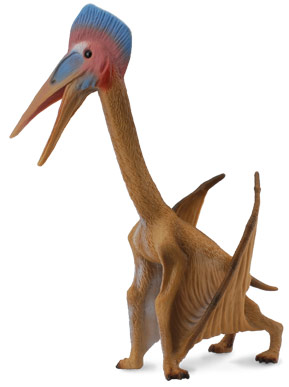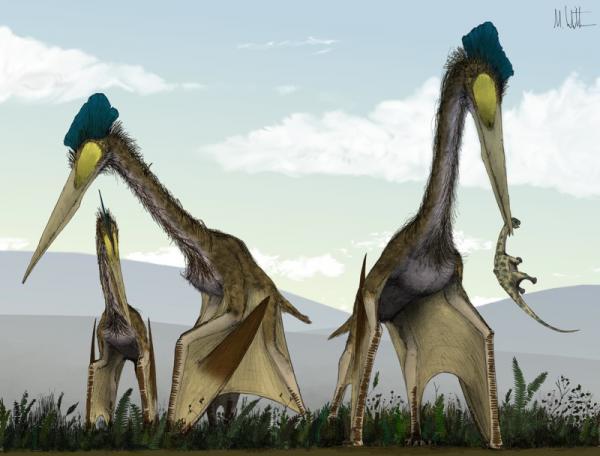Understanding the Astonishing Azhdarchid Pterosaurs
What Role in Ecosystems did Giant Azhdarchid Pterosaurs Have?
Ask a young dinosaur fan to name a flying reptile and in all likelihood they will come out with the name of one of the really large Late Cretaceous pterosaurs. Pteranodon will probably feature (member of the Pteranodontia), which once boasted as many as eleven species in this genus, but now most palaeontologists except the revision down to just two (P. sternbergi and the geologically younger P. longiceps).
Azhdarchid Pterosaurs
However, matching Pteranodon in popularity and exceeding it in terms of wingspan come the likes of Hatzegopteryx and Quetzalcoatlus. These two flying reptiles are representatives of the enigmatic Azhdarchidae and as such could be regarded as the most spectacular of all the flying reptiles known to science.
A Model of the Giraffe-sized Pterosaur Called Hatzegopteryx
Picture credit: Everything Dinosaur
The picture above features the CollectA Hatzegopteryx model, to view the range of pterosaurs and other flying reptiles in this series: CollectA Prehistoric Life Models.
Azhdarchid Pterosaur Study
There is no doubting some of these azhdarchid pterosaurs were giants, Hatzegopteryx (H. thambema), for example, was taller than a giraffe and its wingspan could have exceeded twelve metres. Quetzalcoatlus from Upper Cretaceous sediments of Texas, is believed to have been even bigger.
When the huge skull is considered, one of the largest known in the tetrapods (excluding marine animals such as the cetaceans), when the robust post cranial fossil material associated with Hatzegopteryx is examined closely, it seems incredible that these large creatures were able to take to the air. However, when the global distribution of the fossils is considered along with aerodynamic wing shape studies, it seems that most of the Azhdarchidae were indeed accomplished fliers.
An Important Question to Answer
This begs the question, what role in the Late Cretaceous ecosystem did these toothless giants have? There have been a number of research papers published exploring this area of pterosaur research. Recently, Mark Witton, a leading expert on the Pterosauria (University of Portsmouth) collaborated with Darren Naish (University of Southampton) to produce an intriguing paper in the latest edition of the quarterly journal “Acta Palaeontologica Polonica” on this very subject.
Both these eminent British scientists have written extensively on the Pterosauria before, but in this new paper entitled “Azhdarchid Pterosaurs: Water-trawling Pelican Mimics or “Terrestrial Stalkers”?”, they conclude that large azhdarchid pterosaurs were very probably terrestrial hunters, perhaps filling a role in ecosystems similar to that of the Maribou Stork (Leptoptilos crumenifer) today.
Terrestrial Predators
These storks are large wading birds and are widespread in sub-Saharan Africa. They have a reputation for eating almost anything that can fit into the mouths including rubbish from garbage dumps. They do feed on carrion and it has been proposed that azhdarchid pterosaurs were scavengers too, but these heavy birds also stalk and feed upon a variety of small vertebrates such as frogs, lizards, other birds and small mammals.
The idea that the likes of Hatzegopteryx and Quetzalcoatlus were largely terrestrial hunters, stalking prey – has been challenged on a number of occasions, three main concerns over this hypothesis have been raised:
- Fossils of azhdarchid pterosaurs are frequently found in aquatic deposits
- Aerial water-trawling, where the beak is pulled through the water to catch food in an enlarged throat pouch like that seen in extant pelicans is a more likely feeding strategy
- Large, slow-moving pterosaurs would have been very vulnerable to attack from other predators as they roamed the land
The Ecology of Azhdarchid Pterosaurs
In this new paper, Mark and Darren examine the evidence for these claims and conclude that the fossil evidence does indeed support the idea that these large animals were indeed terrestrial foragers. Firstly, the fact that fossils of azhdarchids are found in strata that represent lacustrine, riverine or marine environments is dismissed as having no real significance with regards to the behaviour of these flying reptiles. Water transport and deposition accounts for a huge proportion of the vertebrate fossil record and therefore, the deposition in aquatic deposits probably has no bearing on the actual lifestyles of these creatures.
Secondly, it is true, that pelicans are very efficient feeders and their pouches do help them forage, but an examination of the joint function of pterosaur jaws indicates that they are entirely different to those of the jaws of pelicans. Pelican beaks are highly specialised compared to those of all other tetrapods, studies of azhdarchid jaw (albeit from very crushed remains in most cases), fossils, suggest that these pterosaur jaws are anatomically very different from those of pelicans.
The researchers cannot find any strong evidence to support the idea that azhdarchids foraged like pelicans.
A Flock of Azhdarchid Pterosaurs Doing What They Do Best – Ground Foraging
Picture credit: Mark Witton
Reviewing Jaw Expansion
In addition, the estimated amount of jaw expansion present in azhdarchids was proportionately much smaller when compared to that of pelicans, even when the asymmetrical jaw joints of azhdarchids are considered. Lots of other reptiles from the fossil record also show evidence of asymmetrical jaw joints, yet there is no evidence to suggest that these creatures too, indulged in pelican-like feeding behaviour.
Finally, the researchers refute the idea of these pterosaurs being particularly prone to attack once on the ground. Trace fossils indicate that pterosaurs were quite capable walkers on land and although encumbered by their wings, they were not completely helpless. There are lots of birds around today that adopt a terrestrial foraging strategy, the risks to stalking pterosaurs from a large theropod attack are probably overstated.
Pterosaur Take-offs
For example, studies of pterosaur take-offs indicate that these creatures could probably take to the air quite quickly and when you consider that they would have had a pair of sharp eyes perched some five metres off the ground, the likelihood of a meat-eating dinosaur ambushing them would have been considerably reduced.
So, after a careful examination of the available evidence, the researchers conclude that terrestrial foraging for the likes of Hatzegopteryx remains the most likely feeding strategy. This gives a whole new meaning to the idea of “picking something up for dinner”.
Back in 2013, Mark P. Witton wrote a fantastic book all about the Pterosauria, it was called “Pterosaurs, Natural History, Evolution, Anatomy” and it is well worth purchasing.
Here is Everything Dinosaur’s book review: Pterosaurs Reviewed.



